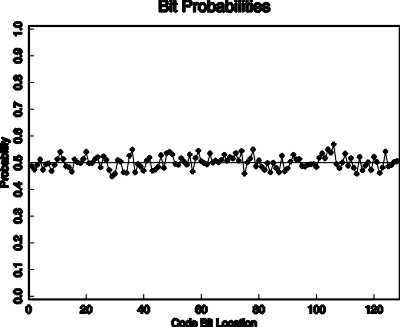Next: Number of Independent Degrees-of-Freedom Up: Code Construction and Entropy Previous: Commensurability of Iris Codes
![]()
![]()
![]()
Next: Number of Independent Degrees-of-Freedom Up: Code Construction and Entropy Previous: Commensurability of Iris Codes
A primary question is whether there is independent variation in iris detail, both within a given iris and across the human population. Any systematic correlations in iris detail across the population would undermine the uniqueness of an iris code. Similarly, any systematic correlations within an iris would reduce its statistical complexity, or dimensionality, and thus also undermine its uniqueness.
A code of any length has maximum information capacity if all its possible states are equiprobable [26]. This reflects the fact that the Shannon entropy measure
for the probability of each of the n states and with
is maximum when for all j,
By construction the 2-D Gabor filters (13) have no DC response in either their real or imaginary parts, as noted earlier. This eliminates possible dependency of the computed code bit conditionals (14) - (17) on mean illumination of the iris and on its contrast gain, and it also renders equiprobable the four vertices of the logical unit square (hRe,hIm) associated with each 2-D Gabor filter. As a consequence of analyzing the iris texture with filters lacking any DC response, the iris code has the property of encoding zero-crossings, which are known [19] to be exceedingly rich in information for bandlimited signals.

Figure 5: Equiprobable variation of iris code bits, for each of 128 code bit locations,
across a population of 592 different iris codes.
The variation among iris code bits as defined above in (14) - (17) was tracked both across bit location within the code and across a population of 592 different iris codes. The ethnic groups and nationalities included in this sample are listed in Section 5.1, together with further database details. For each of 128 code bit locations, drawn from all parts of the iris code, Figure 5 plots the probability of a set bit. The graph shows that this is fairly equiprobable across all code bit locations, and that it remains close to one-half. (Mean of the means is ). The flatness of the graph reflects the existence of independent variation in the detailed iris texture, both across an iris and across the human population studied. The amount of independent variation that is typical in a given iris will be quantified in the following Section, which estimates the underlying number of independent degrees-of-freedom in an iris code after its intrinsic correlations have been factored out. Across the population, the constant independent probability of any given code bit being set (i.e. the full equivocation entropy between iris codes) presumably reflects the absence of genetic penetrance in the detailed morphogenesis of this tissue, in favour of stochastic or chaotic processes. Any systematic feature, say at the 12-o'clock position in the iris, would have caused systematic deviation in Figure 5 for the bit probabilities derived from that region. Second, this graph's proximity to a probability of one-half establishes that, since very nearly p=1-p, the iris code is bitwise a maximum entropy code.
![]()
![]()
![]()
Next: Number of Independent Degrees-of-Freedom Up: Code Construction and Entropy Previous: Commensurability of Iris Codes